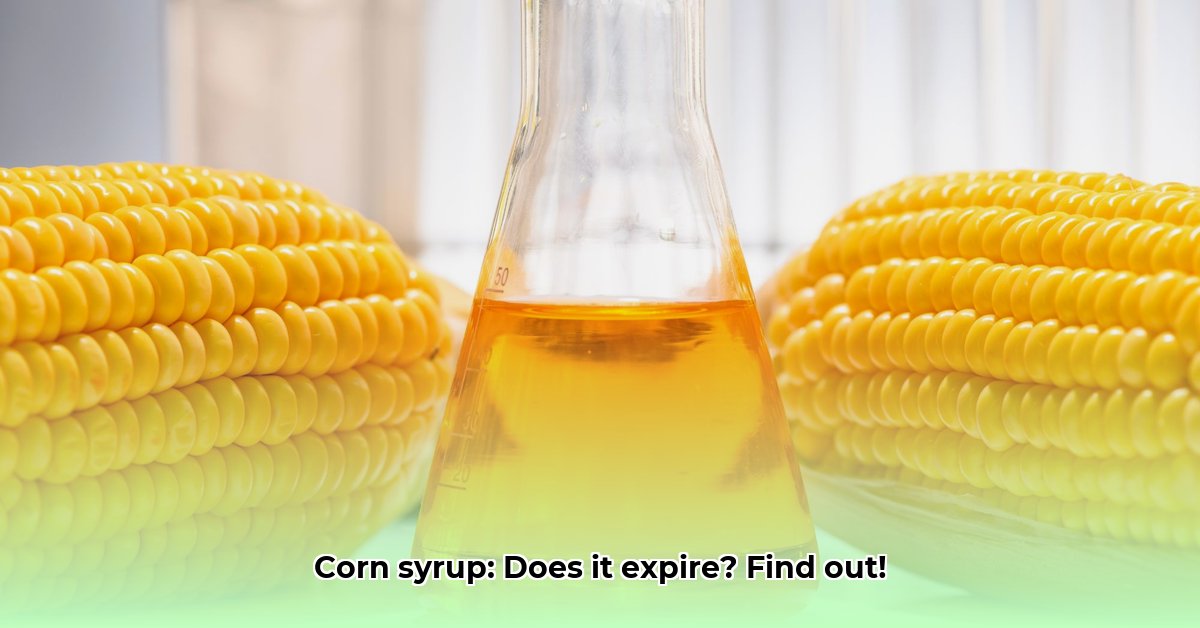Ever wonder about the shelf life of that corn syrup bottle in your pantry? This comprehensive guide provides clarity, explaining corn syrup’s longevity, factors affecting its quality, and practical storage tips. Learn how to confidently use your corn syrup, ensuring it’s both safe and delicious for all your culinary needs. For more on product shelf life, check out this guide on diaper shelf life.
Understanding Corn Syrup: Types, Shelf Life, and Spoilage Indicators
Does corn syrup actually go bad? While it’s unlikely to make you sick, its quality gradually changes over time. It’s surprisingly resilient thanks to its high sugar content, but it doesn’t last forever without some degradation. Let’s explore its shelf life, the science behind it, and how to keep it at its best.
The Science Behind the Surprisingly Long Life of Corn Syrup
Corn syrup boasts an impressive shelf life primarily due to its high sugar content. Sugar acts as a natural preservative, creating an inhospitable environment for bacteria, mold, and other microorganisms—the common culprits of food spoilage. This high sugar concentration pulls moisture away from these microorganisms through osmosis, preventing their growth and multiplication. In essence, it’s a self-preserving system.
What Happens When Corn Syrup Ages? Oxidation, Crystallization, and Flavor Shifts
While corn syrup won’t likely cause illness even when “expired,” expect subtle changes in flavor and texture over time. These changes stem from natural chemical reactions like oxidation and crystallization, not from harmful microbial growth.
- Oxidation: A slow reaction with air that can gradually alter the taste and color, leading to a less appealing flavor profile.
- Crystallization: Sugar molecules clump together, thickening the syrup or making it grainy. This is more common in colder environments.
- Flavor Shifts: Subtle changes in flavor can occur as the syrup ages, potentially affecting the taste of your recipes.
The Secret to Keeping Corn Syrup at its Best: Practical Storage Tips
Several factors play a crucial role in preserving corn syrup’s quality. Here’s what you can do to maximize its shelf life:
- Storage is Key: Store corn syrup in a cool, dark, and dry place, away from direct heat and sunlight. The pantry or a cool cupboard is ideal.
- The Lid is Your Friend: Ensure the container is tightly sealed to prevent air exposure, which can lead to oxidation and moisture absorption.
- Keep it Clean: Prevent contamination by using clean utensils (spoons, measuring cups) when dispensing corn syrup and maintaining a clean storage area.
How to Tell if It’s Time to Say Goodbye to Old Corn Syrup: Sensory Evaluation
Although corn syrup is unlikely to become dangerous, it can still degrade in quality to the point where it’s no longer desirable. Use your senses to assess its condition. Discard it if it exhibits any of the following characteristics:
- Off Smell: A rancid, fermented, or otherwise unpleasant odor.
- Drastic Color Change: A significant darkening or a murky appearance.
- Noticeably Different Texture: Excessive thickness, unusual sliminess, or large, hard crystals.
- Visible Mold: Any sign of mold growth is an immediate cause for disposal.
A “best by” or “use by” date indicates optimal quality as perceived by the manufacturer, not safety. A few small crystals don’t necessarily mean it’s bad, but it might not have the smooth consistency you desire.
How to Store Corn Syrup for Maximum Enjoyment and Safety: A Detailed Guide
Follow these detailed tips to keep your corn syrup in top condition and extend its usable life:
1. Unopened Corn Syrup: Store in a cool, dark, and dry place to maintain its quality for several years, potentially indefinitely. A pantry or cupboard away from heat sources is ideal.
2. Opened Corn Syrup: For the best flavor and texture, aim to use opened corn syrup within six months to one year. Always reseal the container tightly immediately after use to minimize air exposure and prevent contamination.
3. Avoid Extreme Temperatures: While refrigeration isn’t necessary, avoid storing corn syrup near heat sources like ovens or in areas with fluctuating temperatures.
4. Don’t Freeze: Freezing can alter the texture and consistency of corn syrup, leading to crystallization and separation.
Corn Syrup Shelf Life: A Quick Summary of Storage Impacts
| Factor | Effect on Shelf Life |
|---|---|
| High Temperature | Reduces shelf life; speeds up oxidation and crystallization |
| Light (Sunlight) | Reduces shelf life; speeds up oxidation |
| Air Exposure | Reduces shelf life; speeds up oxidation and moisture absorption |
| Contamination (e.g., mold) | Reduces shelf life; renders unusable |
| Proper Storage (Cool, dark, sealed) | Extends shelf life; maintains quality |
Corn syrup is a remarkably stable food product and doesn’t typically become harmful, but its quality declines gradually over time. Trust your senses, follow these storage tips, and enjoy your corn syrup in your favorite recipes.
How to Tell if Opened Corn Syrup Has Gone Bad: A Detailed Sensory Inspection Guide
Opened corn syrup generally has a long shelf life thanks to its high sugar content, which inhibits microbial growth. However, quality degradation can still occur over time, affecting its flavor and usability. Consider these detailed sensory inspection steps to assess if your opened corn syrup is still suitable for use:
- Unopened corn syrup boasts a remarkably long shelf life due to its high sugar content, making it resistant to spoilage.
- The “best by” or “use by” date is primarily a quality indicator, not a strict safety deadline. Changes in taste and texture are the primary signals of quality decline.
- How to tell if opened corn syrup has gone bad? Conduct a thorough visual inspection, smell test, and texture assessment.
- Inspect for cloudiness, discoloration, or the presence of mold.
- Smell is a crucial indicator. A sour, fermented, or otherwise off-putting aroma is a strong signal that it’s time to discard the syrup.
- Proper storage is paramount. Always keep corn syrup in a cool, dark, and dry place, tightly sealed.
Understanding Corn Syrup’s Shelf Life: Spoilage vs. Quality Degradation
It’s important to differentiate between true spoilage and simple quality degradation. Corn syrup resists microbial infestation exceptionally well due to its high sugar concentration. Quality degradation, on the other hand, refers to changes in color, flavor, or texture that occur over time, even without actual spoilage. This degradation differs significantly from “going bad,” which implies a potential health risk due to bacterial or fungal growth.
Visual Clues: Recognizing Spoilage Signs
One of the most reliable methods for determining if your opened corn syrup has deteriorated is a thorough visual inspection. How to tell if opened corn syrup has gone bad based on visual cues? Focus on the following:
- Color: Look for significant darkening (more than a slight amber hue) or a murky, cloudy appearance.
- Crystallization: Small sugar crystals are generally harmless and can be dissolved by gently warming the syrup. However, large, hard crystals or a significant amount of crystallization may indicate quality decline.
- Mold: Any visible mold growth, whether on the surface of the syrup or around the container’s edge, is a clear sign of spoilage, and the syrup should be discarded immediately.
Olfactory Assessment: Trust Your Nose
Engage your sense of smell. A rancid, fermented, or otherwise unpleasant odor is a strong indicator of diminished quality. While this doesn’t necessarily mean the syrup is unsafe to consume, its flavor and texture have likely become unacceptable for most culinary applications.
Texture Changes: A Sign of Degradation
Pay close attention to the texture of the corn syrup. Graininess (beyond minor crystallization) or an unusual thickness can indicate a gradual breakdown of sugars or the introduction of moisture, which can compromise its quality.
Storage Practices: Maximizing Shelf Life
Proper storage in a cool, dark, and dry location is essential for extending corn syrup’s quality. A tightly sealed container will prevent moisture absorption, which can accelerate quality loss and increase the risk of microbial growth.
When to Discard Corn Syrup: Balancing Judgement with Risk
Ultimately, deciding whether to discard opened corn syrup depends on a combination of careful sensory evaluation, your personal tolerance for risk, and the intended use of the syrup. If the syrup fails any of the visual inspection, smell test, or texture assessment criteria outlined above, it’s best to err on the side of caution and discard it.
Understanding Corn Syrup Spoilage Factors in Various Climates and Environments
Corn syrup, especially high-fructose corn syrup (HFCS), has a long shelf life primarily due to its high sugar content. However, understanding corn syrup spoilage factors in various climates and environments is essential for maximizing its usability and preventing unnecessary waste.
- Unopened corn syrup can last indefinitely under ideal conditions. Opened containers should ideally be used within 6-12 months for optimal quality.
- Temperature extremes, humidity, and light exposure significantly affect its shelf life.
- The best approach involves consistently storing corn syrup in a cool, dark, and dry place in a tightly sealed, airtight container. Avoid freezing the syrup, as this can alter its texture.
- The expiration date printed on the packaging is a guideline for peak quality, not an absolute indicator of spoilage. Always use your senses to check for unusual odors, mold growth, or significant texture changes before
- Gluten Free Meal Prep Ideas for Delicious, Hassle-Free Eating - November 28, 2025
- Gluten Free Meal Prep for Stress-Free and Healthy Eating - November 27, 2025
- Quick And Easy Chicken Thigh Meal Prep For Weight Loss - November 26, 2025










